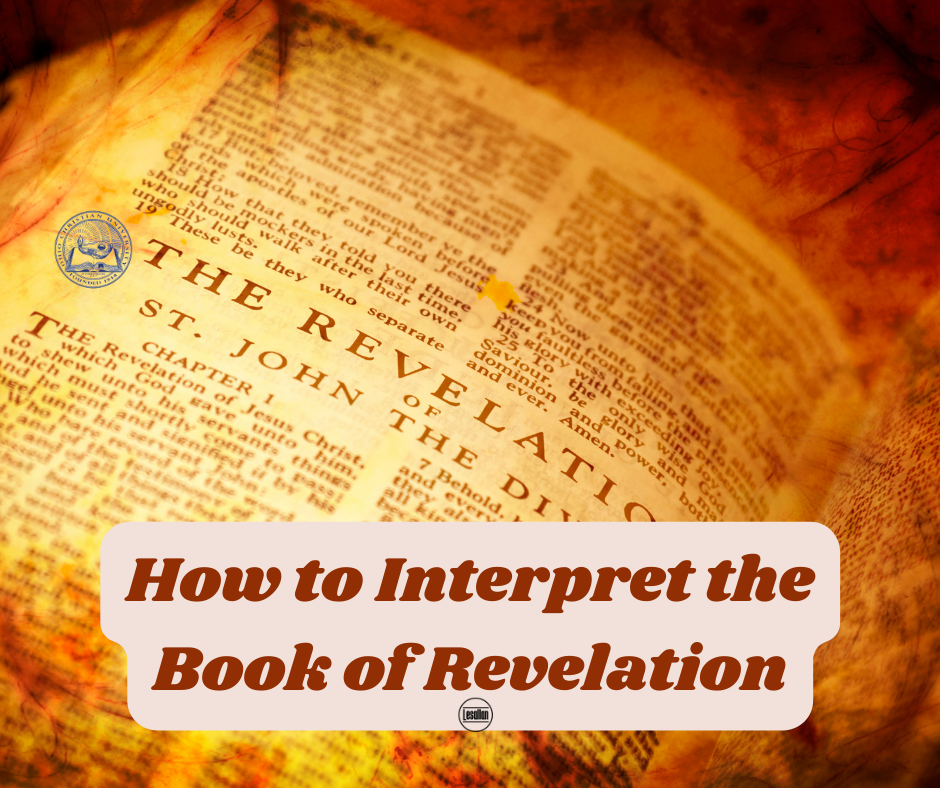Lesallan Bostron
BIB3560 Revelation (ONLSP23)
Ohio Christian University
Pastor Alexander Soultz
April 16, 2023

How to Interpret the Book of Revelation
There are many ways to begin studying the Book of Revelation and interpreting the book.
The Book of Revelation is a very complicated and complex book that contains many symbols, signs, prophecies, and apocalyptic literature. People must read the Book of Revelation with humility and faith that the Holy Spirit can guide all through this book. The same humility and faith must also be shown when studying the Bible’s other sixty-five books. One thing that readers should try and do is discover the original message which was intended for the original readers. The original readers were the ones who faced persecution and suffering in the first century. Attention must be paid to when John of Patmos, the author of Revelation, identifies an image or explains its meaning. John does an excellent job of explaining and identifying images, such as the seven stars being the angels of the seven churches and the seven lampstands being the seven churches (Revelation 1:20, ESV).
We must know all the tools available when interpreting the Book of Revelation. In addition, we must be aware of all the different approaches or methods the interpreters have used to comprehend Revelation. Traditionally there have been four main approaches used by interpreters. The approaches are “the preterist” approach, “the historicist” approach, “the futurist,” and the “idealist approach” (Beale, 1999). The assigned reading for this week also gave a fifth approach called the eclectic approach, which combines elements from several of the approaches mentioned above.
In the first approach, that of the preterist, emphasis is placed on Revelation’s historical context. The preterist tries to understand things like John’s audience would have understood. The second approach (the historicist) is like a map or an outline of what has happened or will happen throughout the church’s history from the first century until the return of Jesus Christ—the historicist views Revelation as the predicting of specific historical events or figures. Thirdly is the view from that of the futurist, which considers that most of the Book of Revelation is related to the events still of the future and preceding the end of time and history. In the fourth view of the idealist, we find an approach that does not interpret the Book of Revelation in any particular reference to time. Instead, this interpretation or view sees the book of Revelation as the ongoing and continual struggle between good and evil, God and Satan. The idealist sees Revelation as a presentation of the timeless truths and principles for Christians in any age. Lastly, or the fifth view, is the eclectic approach, which combines elements found in several of the other four main methods used to interpret the Book of Revelation. There is no definitive answer on how anyone should begin interpreting Revelation. However, many tips and tools will aid you at the beginning of the journey of studying Revelation.
To begin this journey, we must identify the type of literature in the Book of Revelation. This prophetic book, the first literary type, reveals to the reader the events of the end of time, the last days, and the invisible forces and spiritual powers at work in the world and the heavenly realms. This book foretells precisely what will happen at the end of the world and the second coming of Christ. In these times, God will judge the wicked and reward the righteous. The Book of Revelation’s subgenre is that of the apocalyptic literature type, using visions, symbols, and allegories to unveil and reveal God’s plan for the future. The Book of Revelation also uses these visions, symbols, and allegories to encourage His people to remain faithful. What apocalyptic means is that it unveils the divine judgments and the completion of God’s way up to eternal glory. This book shows the reader first prophetic and then apocalyptic, showing us the Antichrist, the disasters on the earth, and mysterious Babylon in clear and precise detail.
One of the most challenging aspects of studying the Book of Revelation is how a person should interpret the imagery in the book. Given that the imagery may often seem strange, symbolic, and even scary, some different principles and general guidelines aid in comprehending the meaning and purpose of the imagery are available. Revelation is a visual prophecy given to John of Patmos through a series of visions. This means that John was describing what he saw in his mind (visions); he was not literal in his description of what would necessarily happen in reality. God intended to communicate His message through John and then to John’s readers. God did not intend to lay out a precise timeline of future events. People must also realize that the Book of Revelation draws heavily on the symbolism and historical context of the first century found in the Old Testament. Many of the images and symbols found in Revelation have their roots or backgrounds in the pages of the Old Testament—the visions and or the prophecies of Daniel, Ezekiel, Zechariah, Enoch, and Ezra. By comparing and contrasting the images found in the Old Testament, significant insight can be gained into interpreting their true meaning and significance.
The images or symbols found in Revelation are frequently explained to us by either John or an angel. For example, it is in an angel tells “John that the seven heads of the beast” are “seven mountains” and “seven kings” and that “the ten horns” are “ten kings who” (Revelation 17:9-18) have given their authority to the beast. Often, a person can infer the meaning of a symbol from the role played within the vision. For example, the woman clothed with the sun in Revelation 12:1-6 can be understood as representing God’s people because she gives birth to the male child, Christ. However, people must also be flexible and cautious with yet a fourth principle, such as Revelation’s numbers and time references. The use of numbers is often symbolic and not to be taken literally. For example, numbers such as seven represent completeness and perfection, while yet the number twelve represents God’s people. In Revelation, the time references are also fluid and are not fixed. Examples can be found in this book with the phrase “a time, times, and a half a time” (Revelation 12:14); these can mean three and a half years or a symbolic period of tribulation.
These principles, as mentioned above, aid us in interpreting the imagery in Revelation. However, there may be more than one valid and legitimate way to understand the imagery and symbols in the Book of Revelation. When interpreting the Book of Revelation, the main goal is not to solve all the mysteries or the puzzle but to see Jesus Christ as our Lord and Savior. From the Beginning to the End, He loves us, and He has freed us from our sin by His blood (Revelation 1:5-8) and us.
Complete interpretation of Revelation begins with identifying the literary type and genre of the book itself. This student has found Revelation to be a prophetic type of literature, with the subgenre being apocalyptic. Many different approaches to interpretation must then be taken into consideration. Approaches such as the preterist, which finds strengths in taking seriously the fact that Revelation claims to be about events that “must soon take place” (Revelation 1:1) and that “the time is near” (Revelation 1:3). The preterist view is weak in that it denies the prophetic quality and literal fulfillment of many of Revelations predictions. This view is weak in its complete contradiction with the Biblical teaching of God’s covenant, Israel being eternal, and that Israel will be fully restored in the future. This view also ignores historical evidence that Revelation was written after 70 A.D. Finally, it fails to account for the global scope and cosmic significance of events described in Revelation, such as the mark of the beast, the resurrection of the dead, and the new heavens and earth.
The historicist approach and view find their strengths in connecting Revelation with church history and encouraging Christians and those facing opposition from world powers. Weaknesses in this approach include being arbitrary and subjective when identifying historical events, such as the fulfillment of prophecy, and having trouble accounting for the events in modern times.
Those with a futurist view find strength in the literal approach taken to the fulfillment of Old Testament prophecies. Prophecies such as Israel are emotionally and psychologically attractive to Christians and others who have not endured tribulation. This futurist greatest weakness is that it is one of Revelation’ most complex and complicated views. The futurist view is weak as it held no relevance for first-century readers and Christians persecuted throughout history.
With the idealist view, strengths are found in avoiding the issues of finding harmony in passages with historical events and then making Revelation applicable, yet relevant to all periods of church history. The weakness of the idealist perspective is that it denies Revelation any specific historical fulfillment, and it is very vague and general when interpreting prophecy.
The last approach is that of the eclectic, which is an approach this student feels most comfortable with. This view and approach have the strength of combing all of the elements of other views and trying to balance the historical context, the symbolic imagery, and the future fulfillment of Revelation. Due to this view being inconsistent and selective in the use of other methods and because there is a lack of coherent framework, this view’s weakness in understanding Revelation is found. Because each view has its own merits and challenges, this student would tend to lean and be most comfortable with the eclectic view as it is the most flexible and balanced approach to Revelation. This view allows for the possibility of finding value and truth in the other views while still being open to correction as new evidence and insights emerge.

References:
Beale, G. K. (1999). Revelation: a commentary on the Greek text. W.B. Eerdmans.
Beasley-Murray, G. R. (1997). “Revelation, Book of.” In Dictionary of the Later New Testament and Its Developments, edited by Ralph P. Martin and Peter H. Davids, 1025–38. Downers Grove, IL: Intervarsity.
BibleProject. (2021). How to Read the Bible: Apocalyptic Literature. Www.youtube.com. https://www.youtube.com/watch?v=UNDX4tUdj1Y
Book of Revelation – ESV – Bible Study Tools. (n.d.). Biblestudytools.com. https://www.biblestudytools.com/esv/revelation/
Mounce, R. H. (1997). The Book of Revelation. W.B. Eerdmans.


